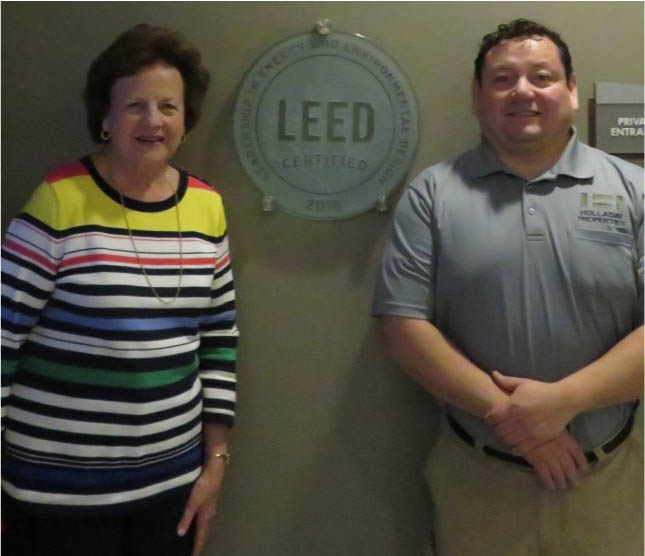By Marcy Coffman, Executive Assistant/Office Manager (Nashville, TN)
Holladay Properties is proud to announce that Yorktown 50 located in Fairfax, VA, was LEED Certified on August 16, 2018, using the LEED O+M: Existing Buildings v2009 rating system and has joined an elite class of buildings that have earned this prestigious certification.
LEED is an acronym for Leadership in Energy and Environmental Design, a green building rating system developed by the U.S. Green Building Council (USGBC) in 1998. LEED was created to define a common standard of measurement for the Commercial Real Estate Industry on what actually constitutes a “green building,” and today it is the most recognized and widely used green building rating system in the world. Projects are awarded points based on the credits they achieve in categories including Sustainable Sites, Water Efficiency, Energy and Atmosphere, Materials and Resources, and Indoor Environmental Quality. Official certification is obtained after submitting an application documenting compliance with the requirements of the rating system and achieving at least 40 points for LEED Certified, 50 points for LEED Silver, 60 points for LEED Gold and 80+ points out of a possible 100 total points for LEED Platinum.
The Yorktown 50 facility was built in 1974 and is six-stories with 99,080 square feet. The building went through a 32-month re-development, which was completed in the fall of 2018. To achieve LEED certification, a building must have measurable strategies in place to improve indoor health for indoor building occupants, reduce (or lessen) energy and water consumption, reduce carbon dioxide emissions and promote sustainable and regenerative material resources cycles.
For Yorktown 50, LEED project specific highlights include:
- Reduction of conventional commuting trips by 44.93%. This aids in reduction for pollution and land development effects caused by conventional commuting trips via single occupant vehicles. This reduction was mainly attributed to the use of fuel-efficient vehicles.
- Installation of a white roof, which reduces heat islands to minimize impacts on microclimates and human and wildlife habitats.
- Indoor water savings by installing efficient plumbing fixtures in the building; the building has reduced indoor water consumption by 31.43% from the baseline, saving an estimated 133,000 gallons per year.
- Green Cleaning and High-Performance Cleaning polices were implemented and entryway matting systems were installed, improving indoor air quality for all employees at the building.
- Waste recycling – the project diverted 100% of durable goods at the buildings and held an event that allowed tenants to bring mixed electronics from work or home and collected 525 pounds of e-waste that could have ended up in the landfill.
The benefits of LEED certification are more than the just credentials. LEED certified buildings on average have 34% lower CO2 emissions, consume 11% less water and 25% less energy, have diverted 80 million tons of waste from landfills and report almost 20% lower maintenance costs than typical commercial buildings.

